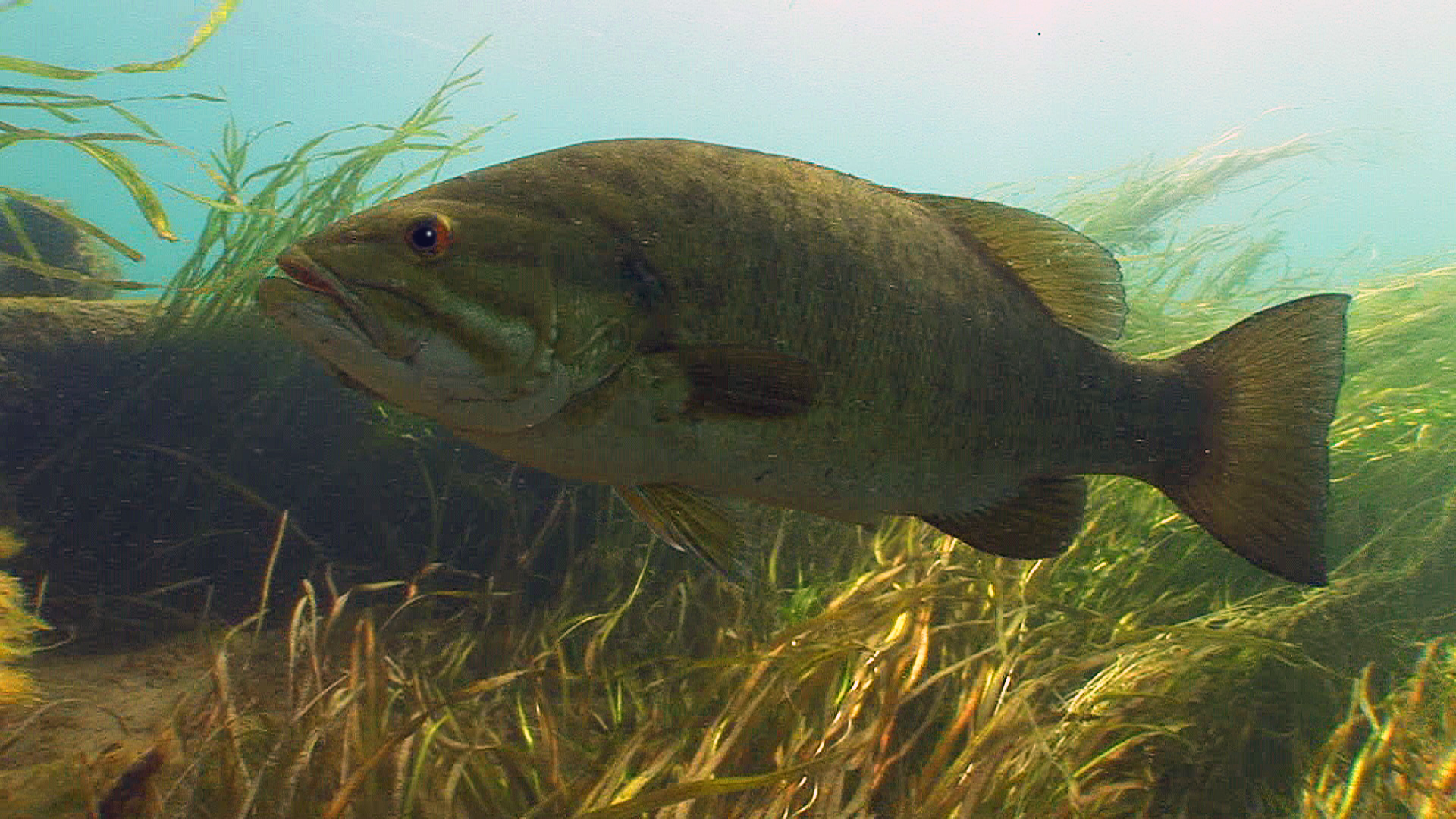
 I Speak for the Fish is a monthly column written by Great Lakes Now Contributor Kathy Johnson, coming out the third Monday of each month. Publishing the author’s views and assertions does not represent endorsement by Great Lakes Now or Detroit Public Television. Check out her previous columns.
I Speak for the Fish is a monthly column written by Great Lakes Now Contributor Kathy Johnson, coming out the third Monday of each month. Publishing the author’s views and assertions does not represent endorsement by Great Lakes Now or Detroit Public Television. Check out her previous columns.
He approached with the speed and accuracy of a homing torpedo and hit the underwater camera with such force that the reverberations traveled all the way up my husband’s arm to his shoulder.
Undeterred by the impact with our camera system, the smallmouth repositioned himself at the far end of the wreckage. He only paused for a moment before once again charging us and hitting the camera with an audible smack.
His nest was about 25 feet away on the other end of a shipwreck but we were still too close for his comfort. To discourage another attack we backed away from the wreckage.
The site is a shipwreck only by the very loosest of definitions. It consists of a single section of wooden decking roughly 25 feet long by 8 feet wide — the sole remnant from some long-lost ship.
The easily accessible location in lower Lake Huron in 15 feet of water on a pristine white sand bottom earned the site the affectionate although not historically accurate moniker of the Sweetheart wreck.
A friend had cautioned us that the resident bass was so aggressive the site was no longer safe to dive. We figured the fish would posture a little and maybe even charge at us. But we never expected him to actually strike us!
We should not have been surprised.
If rock , then smallmouth bass are like 3-year-old police-trained German Shepards: fast, smart, and not to be underestimated.
Pedigree

A smallmouth bass shadows author Kathy Johnson. (Photo Credit: Greg Lashbrook/PolkaDot Perch)
Smallmouth bass, like rock bass, are not bass at all. They are all members of the sunfish family.
Smallmouth bass are mid-sized and deep-bodied fish whose mouths extend backward to the middle of their eye. Their mouths are only small in comparison to some relatives namely the largemouth bass.
Most are dark olive green with tinges of yellow and bronze. Some have dark vertical bars on their sides but the lines are usually broken and the pattern is indistinct. Others appear to be almost completely black. All have pale yellow to cream chins, chests, and bellies.
Smallmouths have a spray of dark bars radiating backward from their eye like elongated lashes. I find these particularly helpful when identifying juveniles.
Another distinguishing feature of juveniles is their tricolored tail which features very distinct bands of orange, black, and white respectively. The eye color ranges from scarlet to pumpkin in both juveniles and adults.
start out feeding on plankton and quickly transition to aquatic insects. They grow rapidly and some may reach 4 inches by the end of their first summer. Most will top out around 12 inches although the Great Lakes record was a monster measuring just a quarter inch shy of two feet.
The average lifespan of a smallmouth bass is 5 to 6 years. The record breaker was estimated to be 16 years old.
Opportunity Knocks

A smallmouth bass aggressively defends his nest in lower Lake Huron. (Photo Credit: Greg Lashbrook/PolkaDot Perch)
Smallmouths are bottom hunters.
They patrol the bottomlands of the Great Lakes looking for crayfish, sculpins, darters, and other small fish including a new favorite round goby.
Smallmouths typically swim a few feet above the bottom, sometimes alone, often in small groups of four or five. The groups tend to fan out in a row like a line of snipers moving through the woods.
These hunting squadrons work in tandem. If one fails to make a kill the next in line is not likely to miss. The only defense most bottom species have against these predators is to hide well and remain hidden until they pass by.
But smallmouth are patient hunters. I’ve seen more than one lay in wait for a crayfish.
Often a crayfish will seek quick cover when a bass approaches and the basses have learned that if they drop downstream, just out of sight, the crayfish will often quickly reemerge. And when they do, the bass’s perseverance is rewarded with a crawdad dinner.
Smallmouths are willing to wait for crayfish because crayfish are hands down their all-time favorite food. It’s the main reason they like shadowing divers so much.
As divers move across the bottom they dislodge rocks, pick up and move debris, and maybe even lift a few logs. Many times, when divers disturb something, the crayfish and other critters that live under that object are spooked into leaving.
To the smallmouth, we’re like diver-shaped Pez dispensers.
Native Warriors
Smallmouth bass are native to North America and were a valued food source for Native Americans.
Throughout the 1800s millions of pounds were taken annually just from Lake Erie. As dams were built across the Great Lakes basin many blocked the upstream migration of spawning bass. In The Fishes of Ohio, Milton B. Trautman notes that huge numbers of bass were then taken as they congregated below the new dams.
By the late 1800s, the commercial catch of smallmouth bass in Lake Erie began dwindling so rapidly that in 1902 the Ohio legislature passed a law prohibiting commercial capture in Ohio waters. Advocates of the law predicted that with commercial fishing pressure removed the bass would return to their former abundance. They didn’t.
The smallmouths’ original range included the Great Lakes and the Saint Lawrence River drainages but they have since spread across North America and have been introduced as far away as Hawaii, Africa, Asia, and Europe.
When introduced, the smallmouth bass often has a negative impact on other native fishes as a result of predation or competition for food. Fisheries experts caution that fish, including smallmouth bass, should never be transported between lakes.
When round gobies were dumped into the Great Lakes the smallmouth did not immediately recognize the new arrivals as a viable food source.
Once the smallmouth realized gobies tasted delicious, it still took a little practice before the bass became proficient at hunting gobies.
One of the challenges for the bass was that round gobies do not react in the same way as native fish. To avoid detection, most native species like remain completely motionless when their shelter is disturbed.
In contrast, gobies dart out of their hiding places in unpredictable bursts like kernels of popping corn.
It took the smallmouths several years to become proficient at targeting and catching round goby. But once they did, gobies became the daily special on the menu.
Guard Dogs

– Smallmouth bass often patrol the perimeter of grass beds looking for dinner. (Photo Credit: Greg Lashbrook/PolkaDot Perch)
Smallmouth bass are nest guarders but unlike their smaller cousins, smallmouth do not nest in colonies. They prefer their nest sites to be widely separated.
The circular nest sites can be anywhere from 1 to 4 feet in diameter. On gravel bottoms, the bass may simply fan away the silt and loose debris without necessarily making a depression. In contrast, on sandy or soft substrates the nests may form very distinct crater-like depressions.
Like rock bass, smallmouths prefer to nest near some type of structure such as log jams, rock ledges, or even shipwrecks.
The male builds the nest in water that ranges from 1 to 15 feet deep.
When the nest is ready, the male hovers over it and flares out his fins. Females are attracted by the male’s vivid spawning colors and courtship display. The female may spawn several times with one male and then move to another nest to spawn with a different male.
Males stay in the nest to protect their eggs and hatchlings. And they will aggressively attack anything that ventures too close.
The eggs hatch in about a week with the male continuing to guard them for several more days. After the fry leave the nest, the male will often clean it and spawn again.
Once they find a good nest site, smallmouths will return to the same spot each year and continue using that site for many years in a row.
Nests in less than 5 feet of water are particularly vulnerable to strong winds, rough waves, heavy undertows, and human interference.
Thankfully, the sweetheart nest site is ideally located. It is deep enough to avoid the bulk of the weather. And, at least among the divers, the word is out that this wreck belongs to a bass.
Catch more news at Great Lakes Now:
I Speak for the Fish: When a bass is not a bass
I Speak for the Fish: Bringing muskie to the masses
Featured image: A pair of smallmouth bass stalk a large crayfish. (Photo Credit: Greg Lashbrook/PolkaDot Perch)
1 Comment
-
As an avid fisherman I appreciate your article.
I have one correction.
You said that smallmouth bass and rock bass are not bass. To be honest every bass is a member of the sunfish family.Every bass is still a bass though.
All bass are subspecies of sunfish as evident in their mating behavior and fin Placement.




